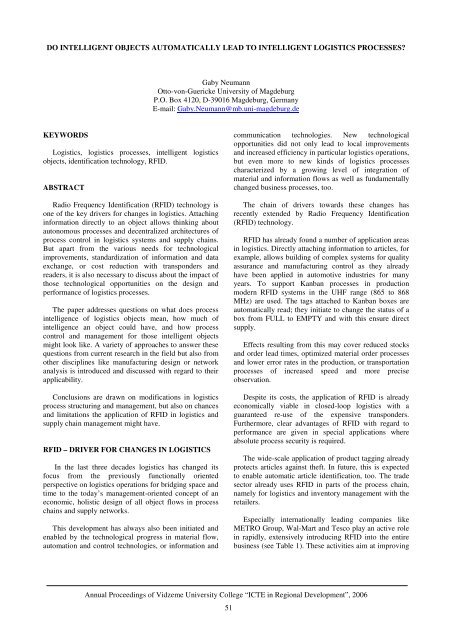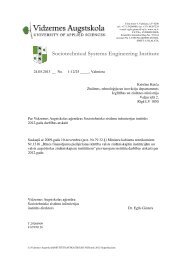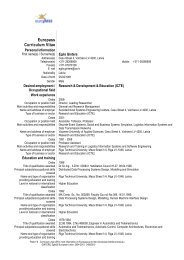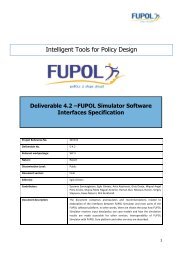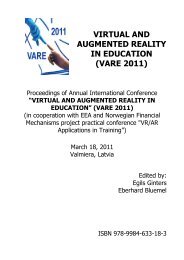employee often will develop their skills dur<strong>in</strong>g real m-Work session.The PUMPURS project No.VPD1/ERAF/CFLA/05/APK/2.5.1/000078/038 is aimed to gather<strong>in</strong>g the<strong>in</strong><strong>format</strong>ion about possible solutions of mobiletechnologies use <strong>in</strong> education and elaboration therecommendations for e-learn<strong>in</strong>g development.CONCLUSIONSRapid changes of ICTE technologies <strong>in</strong> knowledgesociety cause pressure on regularity of the knowledgerenewal <strong>in</strong> areas with high technologies impact, butspecialists have more and more less time for tra<strong>in</strong><strong>in</strong>g dueto job <strong>in</strong>tensity grow<strong>in</strong>g.Especially important and useful are <strong>in</strong>terdiscipl<strong>in</strong>aryknowledge promot<strong>in</strong>g easier <strong>in</strong>troduction of complexmanagement and control systems with high technologiesdom<strong>in</strong>ance.Classical e-learn<strong>in</strong>g is time consum<strong>in</strong>g, but advancede-learn<strong>in</strong>g is not cost effective.To <strong>in</strong>tensify learn<strong>in</strong>g the VET methods must bechanged mov<strong>in</strong>g accents from e-learn<strong>in</strong>g to m-consultation us<strong>in</strong>g mobile cellular technologies.Mobile solutions are direction of communicationtechnologies with highest <strong>in</strong>dex of developmentprovid<strong>in</strong>g new possibilities for VET enhancement.Comb<strong>in</strong>ation of wireless and UMTS technologieswith virtual and augmented reality solutions will be thenext step <strong>in</strong> m-Work environment development.Network<strong>in</strong>g of the research and academic projects isone of efficient ways for gather<strong>in</strong>g, <strong>in</strong>troduction, andma<strong>in</strong>tenance the latest knowledge of different fields.ACKNOWLEDGEMENTThe presented article is supported by the PUMPURSproject No.VPD1/ERAF/CFLA/05/APK/2.5.1/000078/038 and partially funded by the European RegionalDevelopment Fund (ERDF). Many thanks to adjacentprojects LOGIS MOBILE and eLOGMAR-M forcooperation and worthwhile advises.REFERENCESG<strong>in</strong>ters, E., and L. Krecere. 2003. LOGIS Network forKnowledge Dissem<strong>in</strong>ation <strong>in</strong> Logistics In<strong>format</strong>ion<strong>Systems</strong>. HMS 2003. ISBN 9984-32-547-4. Riga, Latvia,September 8-20, 251-255.EduTools. 2006. Course Management <strong>Systems</strong>.Available onl<strong>in</strong>e via [accessed<strong>in</strong> October 10, 2006].Bluemel, E. et al. 2003. Applications of Simulation andIT-solutions <strong>in</strong> the Baltic Port Areas of the AssociatedCandidate Countries. ISBN 9984-30-057-9, Riga: JUMI.Bluemel, E., L. Novickis and S. Strassburger. 2006.eLOGMAR-M Project: IT Solutions for CollaborativeWork Environment with Logistics and MaritimeApplications. In: Scientific <strong>Proceed<strong>in</strong>gs</strong> of the ProjecteLOGMAR-M “IT&T Solutions <strong>in</strong> Logistics andMaritime Applications”. /Edited by E. Bluemel, S.Strassburger and L. Novitsky. ISBN 9984-30-119-2,Riga: JUMI, 9-12.V<strong>in</strong>ichenko, S., L. Novickis, D. Smirnov, K. Staniulisand W. Birskis. 2006. Demonstration Scenarios of Web-Portal with Maritime and Transport LogisticsApplications. In: Scientific <strong>Proceed<strong>in</strong>gs</strong> of the ProjecteLOGMAR-M “IT&T Solutions <strong>in</strong> Logistics andMaritime Applications”. /Edited by E. Bluemel, S.Strassburger and L. Novitsky. ISBN 9984-30-119-2,Riga: JUMI, 51-62.HEA Akademie, 2006. Available onl<strong>in</strong>e via [accessed <strong>in</strong>October 11, 2006].People, 2006. Available onl<strong>in</strong>e via[accessed <strong>in</strong> October 11, 2006].Home Toys Review, 2004. Available onl<strong>in</strong>e via [accessed <strong>in</strong> October 11, 2006].MATRIS, 2004. Available onl<strong>in</strong>e via < http://www.istmatris.org> [accessed <strong>in</strong> October 11, 2006].BIOGRAPHYEberhard Bluemel is the Head of the Division VirtualDevelopment and Tra<strong>in</strong><strong>in</strong>g at the Fraunhofer Institute <strong>in</strong>Magdeburg, Germany. He holds a Ph.D. <strong>in</strong> naturalscience from the School of Mathematics and NaturalSciences Technical University Magdeburg <strong>in</strong> 1985. Hisresearch fields <strong>in</strong>clude discrete optimization, operationsresearch, logistics, simulation, and virtual reality. He isthe project coord<strong>in</strong>ator of several nationally and ECfunded projects of applied research <strong>in</strong> the IT area.Egils G<strong>in</strong>ters is Professor of In<strong>format</strong>ion Technologies<strong>in</strong> IT Department of the Vidzeme University CollegeLatvia and Vice-Rector for Science and Research. Heholds Dr. Sc. Ing. <strong>in</strong> 1996. He is a member of Institute ofElectrical and Electronics Eng<strong>in</strong>eers (IEEE), EuropeanSocial Simulation Association (ESSA) and LatvianSimulation Society.Annual <strong>Proceed<strong>in</strong>gs</strong> of Vidzeme University College “ICTE <strong>in</strong> Regional Development”, 200650
DO INTELLIGENT OBJECTS AUTOMATICALLY LEAD TO INTELLIGENT LOGISTICS PROCESSES?Gaby NeumannOtto-von-Guericke University of MagdeburgP.O. Box 4120, D-39016 Magdeburg, GermanyE-mail: Gaby.Neumann@mb.uni-magdeburg.deKEYWORDSLogistics, logistics processes, <strong>in</strong>telligent logisticsobjects, identification technology, RFID.ABSTRACTRadio Frequency Identification (RFID) technology isone of the key drivers for changes <strong>in</strong> logistics. Attach<strong>in</strong>g<strong>in</strong><strong>format</strong>ion directly to an object allows th<strong>in</strong>k<strong>in</strong>g aboutautonomous processes and decentralized architectures ofprocess control <strong>in</strong> logistics systems and supply cha<strong>in</strong>s.But apart from the various needs for technologicalimprovements, standardization of <strong>in</strong><strong>format</strong>ion and dataexchange, or cost reduction with transponders andreaders, it is also necessary to discuss about the impact ofthose technological opportunities on the design andperformance of logistics processes.The paper addresses questions on what does process<strong>in</strong>telligence of logistics objects mean, how much of<strong>in</strong>telligence an object could have, and how processcontrol and management for those <strong>in</strong>telligent objectsmight look like. A variety of approaches to answer thesequestions from current research <strong>in</strong> the field but also fromother discipl<strong>in</strong>es like manufactur<strong>in</strong>g design or networkanalysis is <strong>in</strong>troduced and discussed with regard to theirapplicability.Conclusions are drawn on modifications <strong>in</strong> logisticsprocess structur<strong>in</strong>g and management, but also on chancesand limitations the application of RFID <strong>in</strong> logistics andsupply cha<strong>in</strong> management might have.RFID – DRIVER FOR CHANGES IN LOGISTICSIn the last three decades logistics has changed itsfocus from the previously functionally orientedperspective on logistics operations for bridg<strong>in</strong>g space andtime to the today’s management-oriented concept of aneconomic, holistic design of all object flows <strong>in</strong> processcha<strong>in</strong>s and supply networks.This development has always also been <strong>in</strong>itiated andenabled by the technological progress <strong>in</strong> material flow,automation and control technologies, or <strong>in</strong><strong>format</strong>ion andcommunication technologies. New technologicalopportunities did not only lead to local improvementsand <strong>in</strong>creased efficiency <strong>in</strong> particular logistics operations,but even more to new k<strong>in</strong>ds of logistics processescharacterized by a grow<strong>in</strong>g level of <strong>in</strong>tegration ofmaterial and <strong>in</strong><strong>format</strong>ion flows as well as fundamentallychanged bus<strong>in</strong>ess processes, too.The cha<strong>in</strong> of drivers towards these changes hasrecently extended by Radio Frequency Identification(RFID) technology.RFID has already found a number of application areas<strong>in</strong> logistics. Directly attach<strong>in</strong>g <strong>in</strong><strong>format</strong>ion to articles, forexample, allows build<strong>in</strong>g of complex systems for qualityassurance and manufactur<strong>in</strong>g control as they alreadyhave been applied <strong>in</strong> automotive <strong>in</strong>dustries for manyyears. To support Kanban processes <strong>in</strong> productionmodern RFID systems <strong>in</strong> the UHF range (865 to 868MHz) are used. The tags attached to Kanban boxes areautomatically read; they <strong>in</strong>itiate to change the status of abox from FULL to EMPTY and with this ensure directsupply.Effects result<strong>in</strong>g from this may cover reduced stocksand order lead times, optimized material order processesand lower error rates <strong>in</strong> the production, or transportationprocesses of <strong>in</strong>creased speed and more preciseobservation.Despite its costs, the application of RFID is alreadyeconomically viable <strong>in</strong> closed-loop logistics with aguaranteed re-use of the expensive transponders.Furthermore, clear advantages of RFID with regard toperformance are given <strong>in</strong> special applications whereabsolute process security is required.The wide-scale application of product tagg<strong>in</strong>g alreadyprotects articles aga<strong>in</strong>st theft. In future, this is expectedto enable automatic article identification, too. The tradesector already uses RFID <strong>in</strong> parts of the process cha<strong>in</strong>,namely for logistics and <strong>in</strong>ventory management with theretailers.Especially <strong>in</strong>ternationally lead<strong>in</strong>g companies likeMETRO Group, Wal-Mart and Tesco play an active role<strong>in</strong> rapidly, extensively <strong>in</strong>troduc<strong>in</strong>g RFID <strong>in</strong>to the entirebus<strong>in</strong>ess (see Table 1). These activities aim at improv<strong>in</strong>gAnnual <strong>Proceed<strong>in</strong>gs</strong> of Vidzeme University College “ICTE <strong>in</strong> Regional Development”, 200651
- Page 1 and 2:
ISBN 9984-633-03-9Annual Proceeding
- Page 3 and 4:
“Development of Creative Human -
- Page 5 and 6: TABLE OF CONTENTSINTELLIGENT SYSTEM
- Page 7 and 8: INTELLIGENT SYSTEM FOR LEARNERS’
- Page 9 and 10: LEARNER 1GROUP OF HUMAN AGENTSLEARN
- Page 11 and 12: QuantityQuantityFigure 6. Distribut
- Page 13 and 14: LEARNERStructure of theconcept mapL
- Page 15 and 16: WEB-BASED INTELLIGENT TUTORING SYST
- Page 17 and 18: materials to be presented and which
- Page 19 and 20: INFORMATION TECHNOLOGIES AND E-LEAR
- Page 21 and 22: correspondence with the course aim
- Page 23 and 24: projects and through IT. Hence, it
- Page 25 and 26: APPLICATION OF MODELING METHODS IN
- Page 27 and 28: can support configuration managemen
- Page 29 and 30: The EKD is one of the Enterprise mo
- Page 31 and 32: CHANGES TO TRAINING AND PERSPECTIVE
- Page 33 and 34: or an end, yet none of these attitu
- Page 35 and 36: make decisions. It cannot be volunt
- Page 37 and 38: logs), data and video conferencing
- Page 39 and 40: Ability to follow user’s multi-ta
- Page 41 and 42: CONCLUSIONSEDUSA method gives us a
- Page 43 and 44: in successful SD. Given this situat
- Page 45 and 46: SPATIAL INFORMATIONFor the visualis
- Page 47 and 48: MOBILE TECHNOLOGIES USE IN SERVICES
- Page 49 and 50: learning environment (Learning Mana
- Page 51 and 52: ago only some curricula on Logistic
- Page 53 and 54: The Web-based version can be access
- Page 55: Web-portal, which incorporates diff
- Page 59 and 60: Table 1. Examples for introducing R
- Page 61 and 62: workable influencing of the process
- Page 63 and 64: are handed over to the objects and
- Page 65 and 66: • Basic processes, such as wareho
- Page 67 and 68: THE ECR E-COACH: A VIRTUAL COACHING
- Page 69 and 70: participating in the workshops and
- Page 71 and 72: • Assessment modules enable indiv
- Page 73 and 74: with pictures and illustrated graph
- Page 75 and 76: ECR Question Banknumber category su
- Page 77 and 78: educational programme that follows
- Page 79 and 80: DEVELOPMENT OF WEB BASED GRAVITY MO
- Page 81 and 82: These results of a model require a
- Page 83 and 84: CONCLUSIONSThe main goal of work ha
- Page 85 and 86: dimension and included within any o
- Page 87 and 88: • Resources sharing by providing
- Page 89 and 90: Pursuant to the guidelines of elect
- Page 91 and 92: tariffs of regulated services have
- Page 93 and 94: INFORMATION TECHNOLOGY FOR MOTIVATI
- Page 95 and 96: difficult to predict when and for w
- Page 97 and 98: Listeners' workon the WebListenersS
- Page 99 and 100: PERSPECTIVES OF WEB PAGE AND E-MAIL
- Page 101 and 102: INCREASE IN THE NUMBER OF INTERNETU
- Page 103 and 104: tourism accommodations (home pages
- Page 105 and 106: interactive relationships with clie
- Page 107 and 108:
• The data obtained by the resear
- Page 109 and 110:
Central Statistical Bureau of Latvi
- Page 111 and 112:
departures for 1995 are taken from
- Page 113 and 114:
120100maximumworldminimum806040200-
- Page 115 and 116:
140120maximumworldminimum1008060402
- Page 117 and 118:
would be a promising extension. Cur
- Page 119 and 120:
AN OVERVIEW OF THE AGENT − BASED
- Page 121 and 122:
Suitability for social system simul
- Page 123 and 124:
6. MASONDescription:MASON is a fast
- Page 125 and 126:
Suitability for social system simul
- Page 127 and 128:
could be bad particularly when over
- Page 129 and 130:
(for 10 repeat &| CCar[]->runfor);P
- Page 131 and 132:
• Streaming audio• Collaboratio
- Page 133 and 134:
NECESSITY OF NEW LAYERED APPROACH T
- Page 135 and 136:
Up to now, there has only been limi
- Page 137 and 138:
aaaaa6= −aa2,1 = − a0,3226= −
- Page 139 and 140:
∂ u∂x∂ u∂y2 2+ b = 02 2wher
- Page 141 and 142:
a6,3= −2030a4,5−130a4,3- - - -
- Page 143 and 144:
0,10,20,30,4( )Mag x y y Ge wx2, =
- Page 145 and 146:
Example 1. To understand better the
- Page 147 and 148:
Therefore, further the following co
- Page 149 and 150:
SOLUTION OF THE THREE-DIMENSIONALEQ
- Page 151 and 152:
Mag1, m , m , m1 2 3= mm1 m2m32 2 2
- Page 153 and 154:
MagMag0, m , m , m1 2 31, m , m , m
- Page 155:
CONCLUSIONSThe basic content of thi


